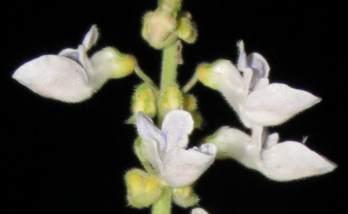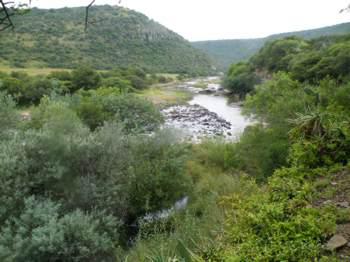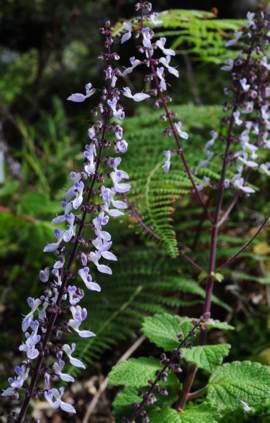Coleus hadiensis
Coleus hadiensis (Forssk.) A.J.Paton (= Plectranthus hadiensis (Forssk.) Schweinf. ex Spreng.)
Family: Lamiaceae
Common names: hairy coleus (Eng.); harigesalie (Afr.); ilozane (isiXhosa); lehlati, imbozisa (Zulu)
Introduction
An attractive perennial shrub, with decorative aromatic foliage, suitable for planting in humid, moist and lightly shaded areas in small gardens.

Description
Description
Coleus hadiensis is a shrubby or herbaceous perennial, up to 1.5 m tall and 1 m wide. The semi-succulent stems are red at the base and leaves are arranged alternately, with axillary buds at the base of leaf petioles. Leaves are ovate to rounded, 35–100 mm wide, delicate, soft and hairy, sometimes variegated. Margins are toothed with 4–14 pairs of teeth.

The terminal inflorescence is 500 mm long with pairs of side branches and mauve or white flowers arranged in whorls, 10–30 mm apart. Flowering time is from autumn to winter with a peak in autumn (April to June). The corolla is 8–15 mm long, with a down-turned tube that widens towards the throat. Calyx is 2–3 mm long and enlarges to 5–6 mm after flowering.

Dark brown, ovoid nutlets, 8 mm in size, are formed and released when ripe.
Conservation Status
Status
Coleus hadiensis is not threatened and is assessed as Least Concern (LC) on the Red List of South African Plants.
Distribution and habitat
Distribution description
Coleus hadiensis has a widespread distribution from the Eastern Cape and KwaZulu-Natal provinces in South Africa to the Arabian Peninsula. It occurs in forest and open grassland, in well-drained, rich soil, usually amongst rocks, where annual rainfall is between 700 and 1000 mm per annum.

Derivation of name and historical aspects
History
The name Coleus is derived from the Greek koleos, meaning ‘a sheath’, and refers to the fused stamens of the type species for the genus.The species name hadiensis is derived from the Arab name from where it was first collected, the Hadiyah Mountains in Yemen. This species was until 2019 placed in the genus Plectranthus, until molecular studies on Plectranthus and closely related genera by Paton et al resulted in the revision of the genus in 2019 and the re-instatement of the genus Coleus. This species falls within the ‘coleus clade’ and is therefore renamed as Coleus hadienis. The name Plectranthus is derived from the Greek words anthus meaning ‘flowers’ and plectron meaning ‘spur’, which refers to the characteristic spur on the base of the corolla tube of the type species for the genus, hence the common name spurflower.
Coleus is a genus in the sage family, Lamiaceae. Members of the Lamiaceae typically have square stems, whorled flower arrangements, aromatic oils and two-lipped flowers.
Coleus hadiensis was first discovered by Pehr Forsskål in Hadiyah, Yemen and it was named Ocimum hadiensis in 1775 in the Flora of Egypt and Arabia (Van Jaarsveld 2006). The genus Plectranthus was not yet established, but it was the first Plectranthus to be described although it was only transferred to Plectranthus in 1894 by the botanists Schweinfurth and Sprenger. Paton transferred it to Coleus in 2019.
Coleus hadiensis is closely related to Coleus grandidentatus which has light green leaves with large-toothed margins, and Coleus madagascariensis which has smaller leaves, a cascading growth habit and white flowers.
Three varieties of Coleus hadiensis are recognized:
var. hadiensis which occurs in the middle and coastal areas of KwaZulu-Natal and the eastern parts of South Africa;
var. tomentosus, which is found in semi-coastal areas from the Kei River towards the coast of KwaZulu-Natal and extending inland along the Mpumalanga Drakensberg and is a large, erect shrub with subrotund leaves and occasionally with tuberous roots;
var. woodii, which has tuberous roots that help it to survive fire in the dry woodlands of the Eastern Cape, KwaZulu-Natal and Mpumalanga.
Ecology
Ecology
Coleus hadiensis looks like a soft perennial yet it is surprisingly drought-tolerant. It adapts easily in dry areas, because it has semi-succulent stems. During periods of drought it will wilt, but will recover soon after it receives water. It also has a persistent rootstock from which it will resprout. Stems root at the nodes as they grow and from broken branches, and thus have a way of spreading vegetatively.

Uses
Use
In the past Coleus hadiensis was used to poison fish and used in tradition medicine as an enema. It is also used as a charm against evil spirits.
Coleus hadiensis is a decorative perennial with horticultural potential. Kirstenbosch has a number of cultivars that have been released to the plant trade: ‘Carnegie’, which is a free-flowering shrub with light purple flowers; ‘Mamba Valley’, a groundcover with densely hairy, succulent leaves; ‘Shongweni’ has attractive wedge-shaped leaves with only 2 or 3 teeth; and ‘Penge’ which has attractive variegated foliage and white flowers.
Growing Coleus hadiensis
Grow
Coleus hadiensis has become a good garden plant. It is a decorative plant, fast-growing, easy to propagate, requires little maintenance, ideal for either planting in the garden or for potted specimens, and also gives gardeners who think they don't have green fingers a burst of confidence.
This plant is best propagated vegetatively by means of tip and stem cuttings in summer. Take cuttings from a healthy and disease-free mother stock at the coolest time of the day, preferably morning when the plant is vigorous. Use well-drained soil, such as river sand mixed with perlite, vermiculite or pebbles. Cut the stem at 150 mm, below the node, remove a third of the leaves from the bottom. Rooting hormone is not necessary. Keep the cuttings in a warm, humid area with good air movement and keep the soil moist but not wet. Rooting takes place after 2–3 weeks and once well-established, transplant cuttings into containers and water regularly until they are fully grown. Established plants can be transplanted into bigger containers or into the garden.
Plant them densely together for thick and compact foliage in garden beds. This species performs very well in well-drained, composted soil and requires occasional water in summer. Feed with an organic fertilizer to improve the plant quality. Pinch out spent inflorescence to encourage new growth and buds. Prune the tips of the braches to control and encourage growth.
Few pests attack these plants.
References
- Codd, L.E. 1985. Lamiaceae. Flora of southern Africa, Vol. 28, 4. Botanical Research Institute, Department of Agriculture and Water Supply, Pretoria.
- Paton, A.J., Mwanyambo, M., Govaerts, R.H.A., Smitha, K., Suddee, S., Phillipson, P.B., Wilson, T.C., Forster, P. I. & Culham, A. 2019. Coleus and Plectranthus (Lamiaceae): a tale of more than two genera. Phytokeys 129: 1–158.
- Pooley, E. 1998. A field guide to wild flowers Kwazulu-Natal and the eastern region. Natal Flora Publications Trust, Durban.
- Van Jaarsveld, E. 1987. The Plectranthus handbook. National Botanical Gardens, Cape Town.
- Van Jaarsveld, E. 1994. The genus Plectranthus and the introduction of recent new cultivars. Hortagro 1: 16-18.
- Van Jaarsveld, E. 2006. The southern African Plectranthus and the art of turning shade to glade. Fernwood Press, Vlaeberg, Cape Town.
Credits
Mpendulo Gabayi
Kirstenbosch National Botanical Garden
June 2014
updated by Alice Notten
Kirstenbosch National Botanical Garden
June 2020
Plant Attributes:
Plant Type: Perennial, Shrub
SA Distribution: Eastern Cape, KwaZulu-Natal
Soil type: Loam
Flowering season: Autumn, Winter
PH:
Flower colour: White, Pink, Mauve/Lilac
Aspect: Morning Sun (Semi Shade)
Gardening skill: Easy
Special Features:
Horticultural zones









Rate this article
Article well written and informative
Rate this plant
Is this an interesting plant?
Login to add your Comment
Back to topNot registered yet? Click here to register.